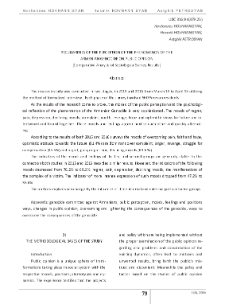Object
Title: Peculiarities of The Perception of The Phenomenon of The Armenian Genocide on Public Opinion
Journal or Publication Title:
Date of publication:
Volume:
Number:
ISSN:
Remainder of title:
(Comparative Analysis of Sociological Survey Results)
Corporate Creators:
Խ․ Աբովյանի անվան հայկական պետական մանկավարժական համալսարան
Coverage:
Abstract:
The research study was conducted in two stages, in 2015 and 2016 from March 15 to April 15 utilizing the method of formalized interview. Each phase of the survey involved 560 Yerevan residents. As the results of the research come to prove, the mosaic of the public perception and the psychological reflection of the phenomenon of the Armenian Genocide is very sophisticated. The moods of regret, pain, depression, declining moods, complaint, wrath, revenge, hope and optimistic views for future are intertwined and bound together. These moods and feelings appear next to each other and quickly alternating. According to the results of both 2015 and 2016 surveys the moods of overcoming pain, faith and hope, optimistic attitude towards the future (91.4%) are dominant over complaint, anger, revenge, struggle for compensation (85.5%) and regret, pain, depression, declining moods (69.6 %). The indicators of the moods and feelings of the first and second groups are generally stable. In this connection both studies in 2015 and 2016 recorded similar results. However, the indicators of the following moods decreased from 76.2% to 69.6%: regret, pain, depression, declining moods, the manifestations of the complex of a victim. The indicator of more intense expression of such moods dropped from 47.2% to 35.6%. The authors explain such change by the influence of three internal and external political factor groups.
Place of publishing:
Երևան
Publisher:
Format:
Identifier:
oai:arar.sci.am:370041
Language:
Object collections:
Last modified:
Oct 8, 2025
In our library since:
Feb 14, 2024
Number of object content hits:
70
All available object's versions:
https://arar.sci.am/publication/399837
Show description in RDF format:
Show description in OAI-PMH format:
-
Իմաստություն=Wisdom=Мудрость
-
Իմաստություն, 2013, N 1
-
Իմաստություն, 2014, N 1 (2)
-
Իմաստություն, 2014, N 2 (3)
-
Իմաստություն, 2015, N 1 (4)
-
Wisdom, 2015, N 2 (5)
-
Wisdom, 2016, N 1 (6)
- Editorial board
- Content
- Editor`s Foreword
- The Concept of Social Progress: an Epistemological Moment
- Transformational Logic and Social Transformation
- Epistemological-Motivational Bases of Literary Non-Fiction Genre as Factors Determining The Linguistic Structure of Text
- Advanced Scientometric Databases as an Objective Criterion of Scientific Activities
- Science and Religion
- The New Design Argument and God
- Culture and World Order
- The Chief and His Sacral Power
- Peculiarities of The Perception of The Phenomenon of The Armenian Genocide on Public Opinion
- Ideological Intersections of Personality’s Analysis In Armenian and Russian Social-Philosophical Thought
- The Shy Stalinism
- Fractionalization of Unrecognized States in Europe
- The Principle of Separation of Powers in Political Science
- Modernism and Feminism
- Philosophical Foundations of Second Language Acquisition
- Saint Gregory The Illuminator and Canons of Nicene Ecumenical Council
- Haig Khatchadourian
- Instructions to authors
- The Authors
-
Wisdom, 2016, N 2 (7)
-
Wisdom, 2017, N 1 (8)
-
Wisdom, 2017, N 2 (9)
-
Wisdom, 2018, N 1 (10)
-
Wisdom, 2018, N 2 (11)
-
Wisdom, 2019, N 1 (12)
-
Wisdom, 2019, N 2 (13)
-
Wisdom, 2020, N 1 (14)
-
Wisdom, 2020, N 2 (15)
-
Wisdom, 2020, N 3 (16)
-
Wisdom, 2021, N 1 (17)
-
Wisdom, 2021, N 1 (1) Special issue
-
Wisdom, 2021, N 2 (18)
-
Wisdom, 2021, N 3 (19)
-
Wisdom, 2021, N 4 (20)
-
Wisdom, 2022, N 1 (21)
-
Wisdom, 2022, N 1 (2) Special issue
-
Wisdom, 2022, N 2 (22)
-
Wisdom, 2022, N 2 (3) Special issue
-
Wisdom, 2022, N 3 (23)
-
Wisdom, 2022, N 3 (4) Special issue
-
Wisdom, 2022, N 4 (24)
-
Wisdom, 2023, N 1 (25)
-
Wisdom, 2023, N 2 (26)
-
Wisdom, 2023, N 3 (27)
-
Wisdom, 2023, N 4 (28)
-
Wisdom, 2024, N 1 (29)
-
Wisdom, 2024, N 2 (30)
-
Իմաստություն, 2013, N 1
| Edition name | Date |
|---|---|
| Hovhannisyan, Hovhannes, Peculiarities of The Perception of The Phenomenon of The Armenian Genocide on Public Opinion | Oct 8, 2025 |





